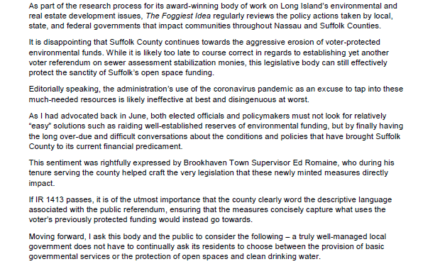The following was written for Long Island Business News, and published on 2/20/13. The piece can be read online here
Newsday famously wrote that in 1978, Long Island was at a crossroads. They told their readers that we, as a region, can either protect our environment, upgrade our infrastructure and streamline our institutions, or let Nassau and Suffolk go fallow. In 2010, Newsday revisited their special section, looking to see what progress was made. In some respects, we’ve made great progress, with large expanses of open space protected, while in others, the song remains the same: lack of provision of affordable housing, a multitude of governmental layers and massive property tax bills, all for an increasingly slimming return of service.
In their February 15th Editorial, entitled “The Long Island Dream is Unraveling”, the paper stated a sad, but long glossed over fact by Long Island’s power elite and policymakers: The region’s system is not only failing, but has finally failed. What once was the suburban ideal, has become a national joke. The editorial was a power statement on how bad it’s gotten.
Last week after the blizzard, I wrote a piece for the Long Island Business News entitled “Nemo Had Found Us, and the System Failed”, which explored the aftermath of a record setting snow storm. I found that instead of basic government services, residents got stuck with pure governmental gridlock. This gridlock was not the type of that is the result of ideological and party differences like that found in Congress, but something I’d say is even worse. Long Island’s municipal gridlock is the result of years of toxic patronage, political handouts and poor planning. These factors corrode the public trust in government over time. With this corrosion, public participation in government declines, since many perceive the system is rigged anyway. With the public unconnected to the political process, poor policy choices by leaders can be made, with little public outcry. Budgets for vital services get hacked away because their sales tax model is obsolete, while services decline.
I’d always accepted that Long Island’s governmental systems and multitude of political fiefdoms are “quirky” (if that is the word for it), and most residents have accepted this…but now, something is different. Post-Sandy, these layers are not only inefficient, but they are truly dangerous. During the blizzard, lives were put at risk because the roads couldn’t be cleared. During Sandy, homeowners in Nassau had to contend with both rising flood waters, and raw sewage from an antiquated wastewater network. Something must change. As Newsday put it “We’re watching this system become unsustainable, as people flee the region, or dream of doing so.” (source: The Long Island Dream is Unraveling, Newsday Editorial, 2/15/13)
Driving around the days after the storm, I almost lost faith in my hometown. I looked at those streets and knew that this was the result of a broken system. It was awful to see the failure of government in such a tangible, physical way. However, with each unplowed road, with each cold, dark home in the weeks after Sandy, I know that the winds of change aren’t far behind. People have had enough, and even a longstanding, flawed system can reach it’s saturation point.
The dream is in fact unraveling. That doesn’t mean that we, as a region, can’t stop it. We are home to the most educated, accomplished and driven workforce in the country. Our students are nationally ranked. We were once trailblazers who not only set the national model for suburbia, but ignited the environmental movement, created the F-14 Tomcat, the lunar module. Our policies were the first to ban dropside cribs, and harmful detergents that polluted our aquifer. We created the first national seashore, and preserved over 100,000 acres of pristine pine barrens. You mean to tell me, that after New York City banished Tammany Hall , we cannot overcome our challenges?
We live in an age where civilization’s knowledge is available a few keystrokes away at any given moment. We can make government more accessible, can open up the process to the public. We can further integrate technology to bring the system to the public, to nurture communication and interaction. The easiest way to help? Start participating in your local civic association to bring some new ideas and fresh blood to the system. We can attend public hearings at Town hall to see what our Towns are doing. Pay attention to what the planning board has to say, see what the Suffolk County Planning Commission is approving. In the morning, read the papers quickly and inform yourself of the issues.
Once we start participating in our community and government, Long Islanders can use the skills that have made us successful in the workforce to help shape the future direction of our region. Are you a teacher? Give your perspective on the state of the schools, and why certain policies may and may not work. Are you a social worker? Chime in on how client needs changed as a result of government policies. Police officer? What would you do differently during the next weather emergency? Participate in the process. Part of the reason why the system is broken is because we’ve become complacent. If we learn anything from both Sandy and the Blizzard of 2013, it’s that complacency in government, acceptance of the status quo is dangerous.











